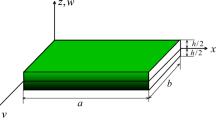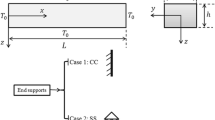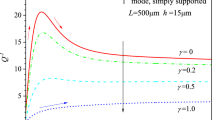Abstract
In this paper, the vibrational behavior of a functionally graded (FG) micro-resonator is investigated for three different configurations based on the Euler–Bernoulli beam model and the Von Karman nonlinear strain assumption. The three configurations include: (1) an FG micro-resonator with a fixed foundation, (2) piezoelectric layers added to the first model, and (3) a second fixed foundation added to the first model. These investigations are performed under the effect of electrostatic forces, the forces caused by the deformations of piezoelectric layers due to the applied voltage, Casimir forces, and uniform temperature changes. The equations governing the vibrational behaviors are obtained using the Hamilton’s principle and the modified couple stress theory. Static deformations and the fundamental vibrational mode are calculated using the differential quadrature method in the spatial domain for all three configurations. Furthermore, the dynamic equations are obtained from the Galerkin discretization and solved with multiple time scales technique. The results show that the frequency behavior of a micro-resonator can be adjusted using the three models.

















Similar content being viewed by others
References
Esfahani S, Khadem SE, Mamaghani AE (2019) Nonlinear vibration analysis of an electrostatic functionally graded nano-resonator with surface effects based on nonlocal strain gradient theory. Int J Mech Sci 1(151):508–522
Naeeni IP, Keshavarzi A, Fattahi I (2019) Parametric study on the geometric and kinetic aspects of the slider-crank mechanism. Iran J Sci Technol Trans Mech Eng 43(3):405–417
Malekzadeh P, Shojaee M (2013) Free vibration of nanoplates based on a nonlocal two-variable refined plate theory. Compos Struct 1(95):443–452
Rahmati M, Khodaei S (2018) Nonlocal vibration and instability analysis of carbon nanotubes conveying fluid considering the influences of nanoflow and non-uniform velocity profile. Microfluid Nanofluid 22(10):117
Fattahi I, Mirdamadi HR (2020) Electro-vibration modeling and response of 3D skeletal frame configuration for energy harvesters. Extreme Mech Lett 4:100646
Malekzadeh P, Haghighi MG, Shojaee M (2014) Nonlinear free vibration of skew nanoplates with surface and small scale effects. Thin Walled Struct 1(78):48–56
Liu W, Wu B, Lim CW (2017) Linear and nonlinear free vibrations of electrostatically actuated micro-/nanomechanical resonators. Microsyst Technol 23(1):113–123
SoltanRezaee M, Bodaghi M, Farrokhabadi A, Hedayati R (2019) Nonlinear stability analysis of piecewise actuated piezoelectric microstructures. Int J Mech Sci 1(160):200–208
Miandoab EM, Yousefi-Koma A, Pishkenari HN, Tajaddodianfar F (2015) Study of nonlinear dynamics and chaos in MEMS/NEMS resonators. Commun Nonlinear Sci Numer Simul 22(1):611–622
Bahadoran M, Noorden AF, Chaudhary K, Aziz MS, Ali J, Yupapin P (2014) Nano force sensing using symmetric double stage micro resonator. Measurement 31(58):215–220
Mestrom RM, Fey RH, Phan KL, Nijmeijer H (2010) Simulations and experiments of hardening and softening resonances in a clamped–clamped beam MEMS resonator. Sens Actuators A 162(2):225–234
Miandoab EM, Yousefi-Koma A, Pishkenari HN, Fathi M (2014) Nano-resonator frequency response based on strain gradient theory. J Phys D Appl Phys 47(36):365303
Azizi S, Ghazavi MR, Rezazadeh G, Ahmadian I, Cetinkaya C (2014) Tuning the primary resonances of a micro resonator, using piezoelectric actuation. Nonlinear Dyn 76(1):839–852
Najar F, Choura S, Abdel-Rahman EM, El-Borgi S, Nayfeh AH (2006 Jan 1) Dynamics of variable-geometry electrostatic microactuators. In: ASME 2006 international mechanical engineering congress and exposition. American Society of Mechanical Engineers, New York, pp 273–281
Pamidighantam S, Puers R, Baert K, Tilmans HA (2002) Pull-in voltage analysis of electrostatically actuated beam structures with fixed–fixed and fixed-free end conditions. J Micromech Microeng 12(4):458
Fleck NA, Muller GM, Ashby MF, Hutchinson JW (1994) Strain gradient plasticity: theory and experiment. Acta Metall Mater 42(2):475–487
Stölken JS, Evans AG (1998) A microbend test method for measuring the plasticity length scale. Acta Mater 46(14):5109–5115
Nayfeh AH, Younis MI, Abdel-Rahman EM (2007) Dynamic pull-in phenomenon in MEMS resonators. Nonlinear Dyn 48(1–2):153–163
Nguyen CC, Ngo VK, Le HQ, Li WL (2019) Influences of relative humidity on the quality factors of MEMS cantilever resonators in gas rarefaction. Microsyst Technol 25(7):2767–2782
Chen HY, Wang KC, Shen HC, Yang CH (2018) Synchronization of uncertain MEMS resonators via adaptive time-varying terminal sliding mode control. Microsyst Technol 2018:1–7
Mohammadi M, Eghtesad M, Mohammadi H (2017) Stochastic analysis of dynamic characteristics and pull-in instability of FGM micro-switches with uncertain parameters in thermal environments. Int J Mech Mater Des 14:1–26
Ghashami G, Khaleghian M, Sabooni M, Jam JE (2016) An exact solution for size-dependent frequencies of micro-beam resonators by considering the thermo-elastic coupling terms. J Braz Soc Mech Sci Eng 38(7):1947–1957
Fattahi I, Mirdamadi HR (2017) Novel composite finite element model for piezoelectric energy harvesters based on 3D beam kinematics. Compos Struct 1(179):161–171
Fattahi I, Mirdamadi HR (2020) A novel multimodal and multidirectional energy harvester by asymmetric 3D skeletal frame structures. J Braz Soc Mech Sci Eng 42:274. https://doi.org/10.1007/s40430-020-02369-4
Fattahi I, Mirdamadi HR (2019) A novel 3D skeletal frame topology for energy harvesting systems. Microelectron J 1(83):6–17
Jia XL, Yang J, Kitipornchai S, Lim CW (2012) Pull-in instability and free vibration of electrically actuated poly-SiGe graded micro-beams with a curved ground electrode. Appl Math Model 36(5):1875–1884
Wang YG, Song HF, Lin WH, Xu L (2017) Large deflection analysis of functionally graded circular microplates with modified couple stress effect. J Braz Soc Mech Sci Eng 39(3):981–991
Gorgani HH, Adeli MM, Hosseini M (2019) Pull-in behavior of functionally graded micro/nano-beams for MEMS and NEMS switches. Microsyst Technol 25(8):3165–3173
Hasanyan DJ, Batra RC, Harutyunyan S (2008) Pull-in instabilities in functionally graded microthermoelectromechanical systems. J Therm Stresses 31(10):1006–1021
Mohammadi-Alasti B, Rezazadeh G, Borgheei AM, Minaei S, Habibifar R (2011) On the mechanical behavior of a functionally graded micro-beam subjected to a thermal moment and nonlinear electrostatic pressure. Compos Struct 93(6):1516–1525
Zhong ZY, Zhou JP, Zhang HL (2017) Thermoelastic damping in functionally graded microbeam resonators. IEEE Sens J 17(11):3381–3390
SoltanRezaee M, Bodaghi M (2020) Nonlinear dynamic stability of piezoelectric thermoelastic electromechanical resonators. Sci Rep 10(1):1–4
Jia XL, Ke LL, Feng CB, Yang J, Kitipornchai S (2015) Size effect on the free vibration of geometrically nonlinear functionally graded micro-beams under electrical actuation and temperature change. Compos Struct 1(133):1137–1148
Trinh LC, Nguyen HX, Vo TP, Nguyen TK (2016) Size-dependent behaviour of functionally graded microbeams using various shear deformation theories based on the modified couple stress theory. Compos Struct 15(154):556–572
Shafiei N, Mousavi A, Ghadiri M (2016) Vibration behavior of a rotating non-uniform FG microbeam based on the modified couple stress theory and GDQEM. Compos Struct 1(149):157–169
Xie X, Zheng H, Yang H (2015) Indirect radial basis function approach for bending, free vibration and buckling analyses of functionally graded microbeams. Compos Struct 1(131):606–615
Malekzadeh P, Shenas AG, Ziaee S (2018) Thermal buckling of functionally graded triangular microplates. J Braz Soc Mech Sci Eng 40(9):418
Khorshidi MA, Shariati M (2016) Free vibration analysis of sigmoid functionally graded nanobeams based on a modified couple stress theory with general shear deformation theory. J Braz Soc Mech Sci Eng 38(8):2607–2619
Rafiee M, He XQ, Liew KM (2014) Non-linear dynamic stability of piezoelectric functionally graded carbon nanotube-reinforced composite plates with initial geometric imperfection. Int J Nonlinear Mech 1(59):37–51
Attia MA, Mohamed SA (2017) Nonlinear modeling and analysis of electrically actuated viscoelastic microbeams based on the modified couple stress theory. Appl Math Model 31(41):195–222
Lamoreaux SK (2004) The Casimir force: background, experiments, and applications. Rep Prog Phys 68(1):201
Mohammadi M, Eghtesad M, Mohammadi H, Necsulescu D (2017) Nonlinear robust adaptive multi-modal vibration control of bi-electrode micro-switch with constraints on the input. Micromachines 8(9):263
Mohammadi M, Eghtesad M, Mohammadi H (2018) Stochastic analysis of pull-in instability of geometrically nonlinear size-dependent FGM micro beams with random material properties. Compos Struct 200:466–479
Eltaher MA, Alshorbagy AE, Mahmoud FF (2013) Determination of neutral axis position and its effect on natural frequencies of functionally graded macro/nanobeams. Compos Struct 1(99):193–201
Shen HS (2016) Functionally graded materials: nonlinear analysis of plates and shells. CRC Press, Boca Raton
Rafiee M, Yang J, Kitipornchai S (2013) Large amplitude vibration of carbon nanotube reinforced functionally graded composite beams with piezoelectric layers. Compos Struct 1(96):716–725
Bodaghi M, Damanpack AR, Aghdam MM, Shakeri M (2012) Non-linear active control of FG beams in thermal environments subjected to blast loads with integrated FGP sensor/actuator layers. Compos Struct 94(12):3612–3623
Kiani Y, Taheri S, Eslami MR (2011) Thermal buckling of piezoelectric functionally graded material beams. J Therm Stresses 34(8):835–850
Najar F, Choura S, Abdel-Rahman EM, El-Borgi S, Nayfeh A (2006) Dynamic analysis of variable-geometry electrostatic microactuators. J Micromech Microeng 16(11):2449
Legtenberg R, Tilmans HA (1994) Electrostatically driven vacuum-encapsulated polysilicon resonators: Part II. Theory and performance. Design and fabrication. Sens Actuators A Phys 45(1):57–84
Malekzadeh P, Shojaee M (2013) Surface and nonlocal effects on the nonlinear free vibration of non-uniform nanobeams. Compos B Eng 52:84–92
Eftekhari S (2015) A modified differential quadrature procedure for numerical solution of moving load problem. Proc Inst Mech Eng Part C J Mech Eng Sci 230(5):715–731
Acknowledgements
This research did not receive any specific grant from funding agencies in the public, commercial, or not-for-profit sectors.
Author information
Authors and Affiliations
Corresponding author
Additional information
Technical Editor: Pedro Manuel Calas Lopes Pacheco, D.Sc.
Publisher's Note
Springer Nature remains neutral with regard to jurisdictional claims in published maps and institutional affiliations.
Appendix
Appendix
In differential quadrature method, the domain is discretized in N grid points along the x-direction. At a given grid point \(x_{i}\), derivatives of a function can be approximated as [51]:
\(A_{ij} ,B_{ij} ,C_{ij}\) and \(D_{ij}\) denote the weighting coefficients, which are used in the first-, second-, third- and fourth-order derivatives, respectively. \(A_{ij}\) is determined as follows:
where \(M\left( {x_{i} } \right) = \mathop \prod \nolimits_{j = 1}^{N} \left( {x_{i} - x_{j} } \right)\). Other weighting coefficients are calculated based on \(A_{ij}\) as:
and
The weighting coefficients of the IQM can be written in the following form [52]:
Rights and permissions
About this article
Cite this article
Mousavi, S.M.J., Sharifi, P., Fattahi, I. et al. On the tuning of static pull-in instability and nonlinear vibrations of functionally graded micro-resonators with three different configurations. J Braz. Soc. Mech. Sci. Eng. 42, 339 (2020). https://doi.org/10.1007/s40430-020-02426-y
Received:
Accepted:
Published:
DOI: https://doi.org/10.1007/s40430-020-02426-y




